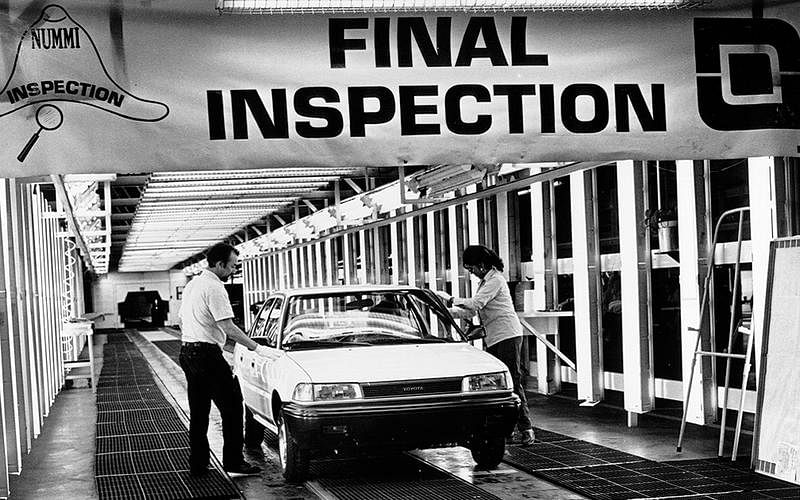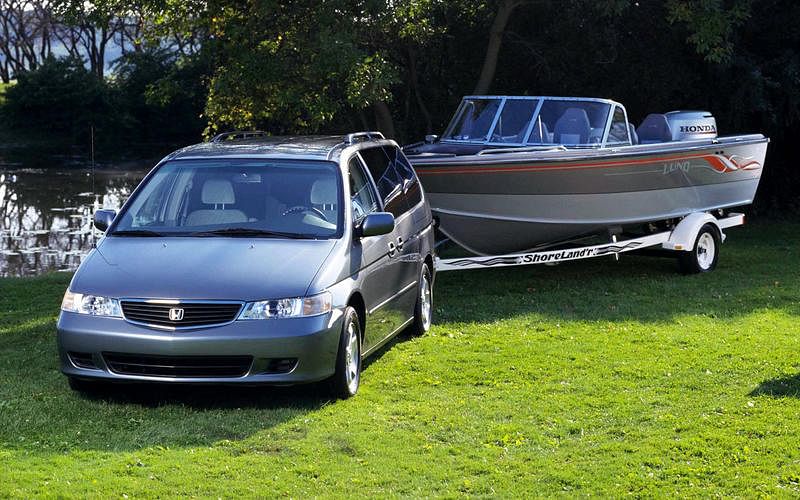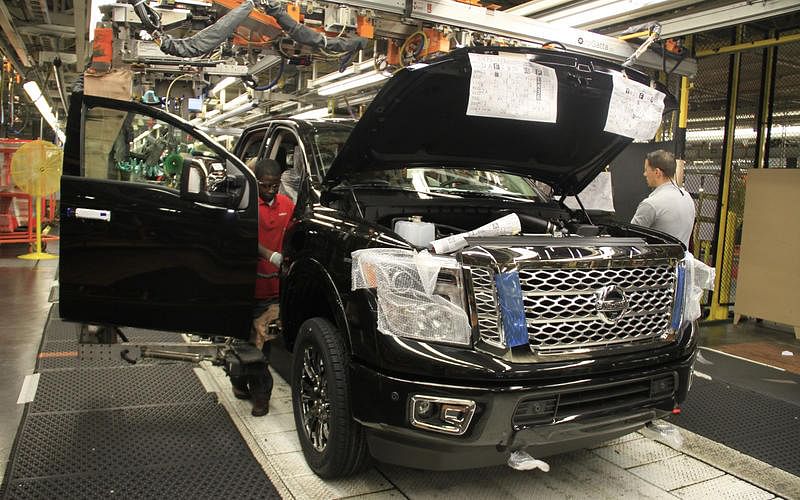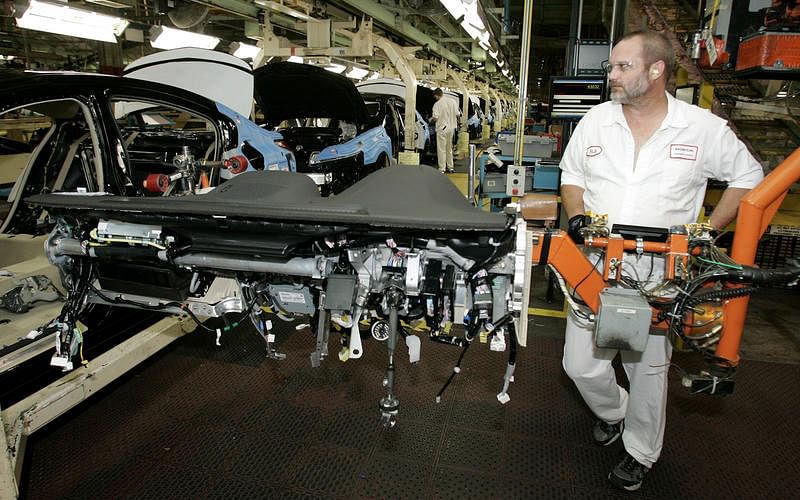Made in America: Japanese car-making in the USA
Japanese car firms have been in America for a long time - and making cars too.
President Trump recently asked Japanese business leaders to build cars in America rather than shipping them across the ocean
While some argue his comments were taken out of context, it’s important to note the world’s largest Japanese automakers have manufactured cars, trucks and motorcycles in the US since the late 1970s. Here’s how it all began, and where it stands today.

1958: Toyota begins US sales
In 1958, Toyota became the first Japanese company to sell a mass-produced passenger car in the US. The Toyopet Crown was a substantial success in Japan but it landed wide of the mark in America. Even Toyota’s own employees in the US criticized the saloon’s lack of power and high price.
Toyota archives indicate its small network of US retailers sold 287 examples of the Crown in 1958, plus a single Land Cruiser. The company withdrew from the American market from 1960 to 1965 as it developed products better suited to buyers’ tastes.

1958: Datsun arrives in America
After conducting extensive market research, Nissan's Datsun brand made its debut at the 1958 Los Angeles Imported Car Show. Its first model for the American market was a saloon named PL210. Datsun sold just 83 cars in the US in 1958, according to its archives department. Sales ballooned to 1290 units the following year.

1968: Subaru dips its toes in the US market
Serial entrepreneur Malcom Bricklin began distributing the tiny Subaru 360 in America in 1968. The 25-horsepower kei car got off to a dreadful start when Consumer Reports called it “the most unsafe car on the market,” citing a litany of shortcomings in the safety department including inadequate brakes. Subaru suffered from the negative publicity for several years, even as it offered bigger, safer and much better cars.

1969: First Honda lands in the US
The first Hondas built for US consumers disembarked in 1969. Sales started on the west coast and the company’s distribution network gradually expanded towards the other side of the country, a common strategy for Japanese automakers. The N600 didn’t sell well outside of major cities due to its restrained dimensions and correspondingly small engine, however. Honda’s success story truly began when it introduced the original Civic for the 1973 model year.
Classic Honda specialist Tim Mings recently found the very first N600 shipped to the US. It came from a batch of 49 cars sent over in 1967 so Honda employees could gain insight into the American market. Run down from decades of sitting in a garage, the N600 was recently treated to a complete restoration.

1970: Mazda enters the American market
Mazda took its first steps in America when it began selling both rotary- and piston-powered vehicles in 1970. Sales were initially confined to the northwestern part of the nation but its presence grew quickly. It created Mazda Motors of America in 1971.
Mazda built numerous cars in America when it was part of Ford, but it has never operated its own factory on US soil. Its only North American production facility is in Mexico. It recently announced plans to build a US factory jointly with Toyota in the coming years.

1971: Chrysler starts selling re-badged Mitsubishi imports
Chrysler purchased a 15-percent stake in Mitsubishi in 1970, and it began selling re-badged imports a year later. The original Dodge Colt was offered as a coupe, a saloon and an estate. All three body styles came directly from Mitsubishi’s factory in Japan.
Additional models joined the line-up during the 1970s and the 1980s. Plymouth – another automaker owned by Chrysler – also sold re-badged Mitsubishi models in the US.

1979: Honda sets up US factory for motorcycles
Government officials lured Honda to Ohio with lucrative tax incentives. The Japanese company built a factory in Marysville, just north of Columbus, to assemble motorcycles like the CR250R for the American market. Everything went according to plan, so Honda quickly began examining ways to start car production in the US. It closed its motorcycle factory in 2009.

1982: First Ohio-built Honda Accord rolls off the line
Encouraged by the success of its motorcycle plant, Honda built a second factory in the Marysville, Ohio, area for cars. Its first Ohio-built car was a gray Accord wearing USA 001 number plates. It has been displayed in the Henry Ford Museum since 1988.
Civic production in Marysville began four years later. In 1988, Honda started exporting the Accord Coupe to its home country of Japan, a move which underlined the importance of its Marysville facility.

1982: Mitsubishi begins US sales
In 1982, Mitsubishi began selling cars under its own name in the US. Its lineup originally consisted of the Cordia, the Tredia and the Starion. They all shared several mechanical components with re-badged Dodge and Plymouth models, though the Starion received a turbocharged four-cylinder engine.

1983: Nissan opens first US plant
Nissan chose Tennessee for its first US factory. A white pick-up truck marked the beginning of production in June of 1983. Today, Nissan’s Smyrna plant produces the Altima, Maxima, Pathfinder, Leaf and Rogue models, plus the Infiniti QX60. It has an annual capacity of 640,000 vehicles.

1984: Toyota, General Motors re-open Fremont factory
General Motors closed its Fremont, California, factory in 1982. The plant re-opened in 1984 when GM teamed up with Toyota to create a joint-venture named New United Motor Manufacturing, Inc (NUMMI). GM wanted to learn how Toyota built cars in Japan, while Toyota needed to establish a manufacturing base in the US to make cars for the local market.
The NUMMI factory produced dozens of different models including Toyota’s Corolla and Tacoma models, the Chevrolet Nova, the Pontiac Vibe and the Geo Prizm. GM pulled out of the joint-venture in 2009 as it navigated through bankruptcy, and Toyota announced plans to close the factory shortly after. Again, the plant didn’t remain idle for long. Tesla purchased the NUMMI factory in 2010. Today, it builds the Model S, the Model X and the Model 3 there.

1985: Suzuki gives Chevrolet an entry-level model
The first Suzuki sold in the US wore a Chevrolet emblem. The Cultus became the Sprint as it emigrated from Japan in 1985. It was joined by the four-wheel drive Samurai SUV, which earned severe criticism from Consumer Reports for its tendency to roll over during evasive maneuvers. Like Subaru decades earlier, Suzuki worked hard to surmount the negative publicity.
Suzuki assembled the Metro and the Tracker in Ontario, Canada, but it has never operated a wholly-owned factory in the US. Its American car-building division filed for bankruptcy in 2012 and exited the market shortly after.

1988: Mitsubishi, Chrysler build factory in Normal, Illinois
Mitsubishi and Chrysler established a joint-venture named Diamond-Star Motors in 1985, and they opened a factory in Normal, Illinois, three years later. The plant initially manufactured the Mitsubishi Eclipse, the Plymouth Laser and the Eagle Talon, three similar-looking coupes built on the same platform.
Mitsubishi purchased Chrysler’s 50-percent stake in the factory in 1991, though it continued to build Chrysler products under contract. The plant closed in 2016, and it is now owned by a startup company named Rivian that aims to challenge Tesla in the electric vehicle sector.

1988: Toyota’s first wholly-owned American plant goes live
In 1988, Toyota applied the lessons learned from its joint-venture with GM to its first wholly-owned American factory. Located in Kentucky, it began producing the Camry using engines shipped from Japan. The facility gained its own engine assembly line in 1990.
Today, the Kentucky factory (called TMMK internally) is the largest Toyota production facility in the world in terms of capacity. It’s capable of producing 555,000 cars and 600,000 engines annually. It manufactures the Camry, the Avalon and the Lexus ES.
 1989: Honda opens second car factory in Ohio
1989: Honda opens second car factory in Ohio Honda sales soared in the 1980s. The company built its second factory in Ohio in 1989, the same year the Accord passed the Ford Taurus to become America’s best-selling car. Located in East Liberty, a short drive from Marysville, Honda’s second-oldest American car factory currently builds the CR-V plus Acura’s RDX and MDX models.

1989: Subaru, Isuzu open Indiana factory
Subaru and Isuzu unexpectedly ran into a similar problem during the 1980s. They needed to establish a manufacturing base in the US, but they were both too small to build a factory on their own. They teamed up to open an assembly plant in Lafayette, Indiana.
In its early days, the Indiana plant made the Subaru Legacy and the Isuzu Rodeo. Isuzu sold its stake in the plant to Subaru for $1 after sales nose-dived in the early 2000s. It left the American market shortly after, while Subaru continues to thrive to this day.

1999: Honda opens factory in Alabama
Honda joined Mercedes-Benz in Alabama in 1999. The facility now stands out as Honda’s largest van and light truck factory in the world. It builds minivans, SUVs and even pickup trucks, plus the V6 engines that power them. Like the ML, which now wears the GLE nameplate, Honda’s Ridgeline, Odyssey and Pilot models all sing “Sweet Home, Alabama!” loud and proud. The facility also builds the Acura MDX.
 2003: Nissan inaugurates second US factory
2003: Nissan inaugurates second US factory
Nissan expanded its manufacturing footprint in America by constructing a second plant in Mississippi. Opened in 2003, the facility brought thousands of direct and indirect jobs to a state with a historically high rate of unemployment, and no history in auto manufacturing.
Nissan’s Canton factory has built 3.2 million cars and trucks in the past 14 years. It manufactures trucks and SUVs like the Frontier, the Murano, the Titan and the NV vans. The company proudly states its two factories have built 15 million cars and 10 million engines since 1983.

2015: Subaru boosts production capacity in Lafayette
As growth exceeded everyone’s expectations, Subaru struggled to keep up with demand for its American-built cars. In 2015, it invested US$140 million to boost production capacity in Lafayette, Indiana, by 100,000 cars annually. It also stopped building the Toyota Camry, which freed up another 100,000 cars.
The Indiana facility recently started building Subaru’s latest Impreza. It’s scheduled to begin production of an all-new three-row SUV named Ascent early next year. The Ascent will fill the void left by the Tribeca, but insiders suggest it won’t be sold outside of North America.

2016: Honda begins NSX production in Ohio
Honda started building the NSX (which is sold as an Acura in the US) last year. The NSX comes to life in a new facility named Performance Manufacturing Center located at the heart of Honda’s immense Ohio campus. Made to order, the NSX benefits from a blend of cutting-edge manufacturing techniques and human craftsmanship.

2016 in numbers
Japanese automakers made sizable contributions to America’s automotive industry in 2016. Data released by Reuters shows they collectively exported 412,281 cars and trucks from their American factories to countries in all four corners of the globe last year. They built nearly 4 million vehicles and 4.7 million engines in the US. We expect the figures for 2017 will be at least as high.
The Japan Automobile Manufacturers Association notes the nation’s exports to the US amounted to 1.5 million cars last year, down from 3.5 million cars in 1986. Notably, Honda’s American factories built 70 percent of the 1.2 million cars the company sold in the US last year.
 Where the industry stands in 2017
Where the industry stands in 2017
Japan’s four largest car manufacturers operate 11 factories in the US. Toyota is present in Kentucky, Indiana, Texas and Mississippi. Honda builds cars in Alabama, Indiana and two Ohio factories. Nissan runs factories in Mississippi and Tennessee, while hundreds of thousands of Subaru vehicles call Indiana home. In contrast, there is not a single American car factory in Japan.

What’s next?
Japanese automakers will continue investing in the US in the coming years. In August, Toyota and Mazda announced they will form a joint-venture to build a US$1.6 billion factory somewhere in America. The partners predict the plant will open in 2021, though they haven’t identified a precise location yet. Toyota also set aside US$1.3 billion to upgrade its Kentucky factory, where it builds the 2018 Camry.
RELATED ARTICLES
Auto Giants Explore Hybrid Strategy as EVs Hit Speed Bumps
Slower-than-expected EV adoption, tight CAFE norms and ever-present efficiency demands are giving hybrids a second wind ...
Continental Taps India as Global Hub for R&D and Manufacturing
Continental’s spin-off of its automotive business into AUMOVIO marks a strategic shift, placing India’s engineering and ...
India's EV Story: Promise, Progress, and Challenges
Amid the fanfare of new launches and soaring expectations, mainstream buyers remain hesitant.





 09 Nov 2017
09 Nov 2017
 113012 Views
113012 Views





 Ketan Thakkar
Ketan Thakkar


 Shahkar Abidi
Shahkar Abidi


